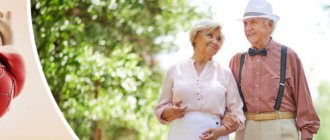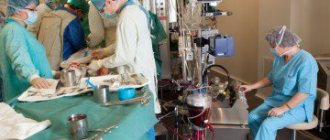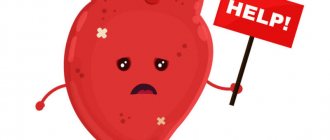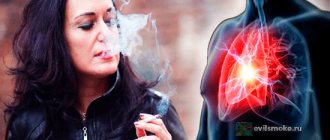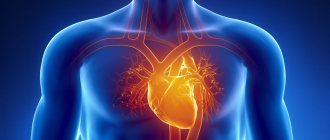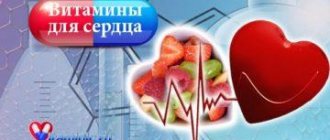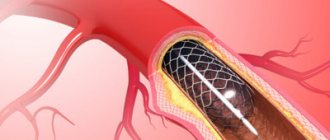Relieving pain during the development of a heart attack or its significant reduction is one of the factors for the favorable recovery of the heart muscle and the prevention of complications. For pain relief, potent drugs from the groups of opiates, neuroleptics, and tranquilizers are prescribed. Nitrous oxide is used as an inhalation method, and local anesthetics are used for injection into the spinal canal.
Why are analgesics needed for a heart attack?
In addition to directly eliminating pain, the administration of analgesics reduces the manifestations of the stress response in response to damage to the heart muscle.
It has been proven that the longer the pain during myocardial infarction lasts, the more intense the formation and entry into the blood of compounds such as adrenaline, norepinephrine, dopamine, which inhibit coronary blood flow. High-intensity pain syndrome leads to frequent development of complications of a heart attack.
Therefore, pain relief is the primary goal of medical care. The administration of painkillers begins at the stage of first aid and continues throughout the course of intensive care.
The main groups of drugs used for analgesia:
- opiates (Morphine, Promedol, Fentanyl);
- centrally acting analgesics (Tramadol, Nalbuphine);
- neuroleptics (Droperidol);
- tranquilizers (Diazepam);
- nitrous oxide;
- local anesthetics (Lidocaine, Trimecaine).
We recommend reading the article about the treatment of myocardial infarction in a hospital. From it you will learn about providing emergency care for a heart attack and treating pain in a hospital setting. And here is more information about pain during myocardial infarction.
Symptoms and first signs of pathology
The typical course of a heart attack is accompanied by pronounced symptoms. The main one is severe chest pain, the intensity of which can cause shock.
Most patients who have suffered a myocardial infarction say that the pain is the worst they have experienced in their lives. However, about a quarter of cases are accompanied by mild symptoms that can be mistaken for ordinary fatigue; these manifestations are more often observed in women.
This course (with atypical symptoms) is very dangerous, since the patient cannot assess the severity of his condition and does not seek help, which should be provided urgently in case of a heart attack. With untimely medical intervention, the likelihood of death increases significantly.
If you immediately consult a doctor, you can stop the development of necrotic lesions and save your life. Moreover, such patients can return to a full life without disability. This is the importance of early recognition of myocardial infarction.
Symptoms in this case include:
| Discomfort, chest pain |
|
| Pain localized in the upper half of the body |
|
| Pain localized in the epigastric region, accompanied by nausea and vomiting |
|
| Respiratory system dysfunction |
|
| Increased anxiety |
|
| Dizziness and hyperhidrosis |
|
Signs can be observed in any combination; in some cases they are practically invisible. About a quarter of myocardial infarction attacks are asymptomatic.
The first signs of a heart attack:
| Increased anxiety |
|
| Chest discomfort |
|
| Cough |
|
| Dizziness | Loss of consciousness, fainting, and dizziness may indicate heart failure. |
| Increased fatigue |
|
| Lack of appetite, nausea |
|
| Pain localized in other places |
|
| Pulse disturbance |
|
| Dyspnea |
|
| Hyperhidrosis |
|
| Swelling | A heart attack can manifest itself as swelling of the ankles, feet, and liver hypertrophy. |
If you notice such signs, you need to know what to do.
Narcotic analgesics
The most powerful painkillers are narcotics. They quickly relieve pain, but weaken breathing, reduce blood pressure, the strength of heart contractions, and lead to the progression of heart failure. Therefore, opiate receptor antagonists and specific antidotes are used for the development of adverse reactions.
Opioid
The most well-known opioid analgesic for myocardial infarction is morphine hydrochloride. It is injected into a vein, muscle or under the skin. The onset of action occurs within 20 - 40 minutes, complete pain relief is observed only in a third of patients. It can suppress the respiratory function of the lungs, the functioning of the digestive system, the secretion of urine, and cause a gag reflex.
Promedol is close in clinical effectiveness to Morphine, but has less negative effects on the respiratory and vomiting centers and the vagus nerve. Fentanyl is almost 100 times stronger than morphine; its effect occurs “at the point of the needle,” but lasts no more than half an hour. Large doses impair breathing and slow the heart rate.
Centrally acting painkillers
Fortral is a blocker of opiate receptors in the brain. It is able to reduce the inhibitory effect of Fentanyl on breathing, without weakening its analgesic effect. The duration of analgesia is approximately 3 hours.
Good results were obtained with the administration of Tramadol and Nalbuphine; they sufficiently reduce the intensity of the pain syndrome, but do not weaken the activity of the respiratory and cardiovascular systems, and are less dangerous for elderly patients.
Shown when available:
- moderate pain in the heart,
- circulatory failure,
- contraindications to narcotic analgesics.
In cases of significant respiratory depression, coronary vasospasm, or decreased myocardial contractility caused by narcotic analgesics, Naloxone is administered. It relieves these side effects, but at the same time weakens their analgesic effect.
Rules for first aid for heart failure
Timely provision of first aid for heart failure helps save lives. Resuscitation does not begin with the arrival of doctors, but in the first seconds after the onset of the attack. The further prognosis of the disease depends on how competent the actions of others are. You need to know how to identify the starting signs of an attack, because no one is immune from disturbances in the functioning of the heart.
First about the reasons
The following factors can provoke an acute attack of heart failure:
- cardiac tamponade,
- heart tissue infections,
- cardiospasm,
- hypertension (in advanced forms of the disease, overload of the left ventricle appears),
- lower lobe pneumonia (right ventricular decompensation often develops).
In people suffering from cardiovascular pathologies (chronic heart failure - CHF, defects), as well as those who have recently suffered a stroke or heart attack, the cause of an attack may be:
- excessive physical activity;
- strong excitement (and not only stress is dangerous, but also positive emotions).
Any of the above reasons can cause a life-threatening condition.
Signs of heart problems
Acute heart failure does not depend on age; even a child can be affected. If a person suddenly grabs the left side of his chest, and his lips and fingers become bluish, this means a sharp disruption in the pumping function of the heart and the inability of the organ to provide adequate blood flow.
According to the localization of the development of heart failure, there are:
- left ventricular
- right ventricular
Both types are equally life-threatening, but they differ in symptoms and when providing first aid, it is necessary to take into account the type of disorder that has arisen.
Left ventricular
The left ventricle is responsible for the blood supply to organs and tissues: thanks to its contractions, blood moves through the vessels, nourishing and cleansing the body of toxins. With a pronounced decrease in blood flow, the following disorders occur:
- blood pressure drops;
- tachycardia appears (by increasing the frequency of contractions, the organ tries to compensate for insufficient blood flow);
- bubbling wheezing occurs in the lungs, foamy sputum is released and an attack of shortness of breath begins (pulmonary edema becomes a serious complication).
Right ventricular
The right side of the heart pumps venous blood to the lungs, where it is enriched with oxygen and removed carbon dioxide (pulmonary circulation). If the right ventricle contracts insufficiently, the following symptoms appear:
- difficulty breathing (the patient begins to breathe more often, taking quick short breaths);
- cyanosis (blue lips, nose and fingertips);
- pain in the right side (with severe hypoxia, the liver suffers).
Both disorders are accompanied by chest pain and a feeling of fear. If a person is not helped in a timely manner, this condition will end in death.
Principles of emergency care
Conventionally, assistance to a patient with an acute attack of heart failure can be divided into 3 stages:
- pre-medical,
- actions of the ambulance team,
- resuscitation measures in the hospital.
Actions before the doctor arrives
First of all, you need to call a medical team. But it is not recommended to simply wait for the doctors to arrive: it will take several minutes for an ambulance to arrive at the specified address, and the person’s condition worsens every second. In order not to panic yourself and to help the patient, you need to learn the following algorithm of actions in advance:
- Provide peace. To do this, you need to make the victim sit more comfortably (you can’t put him on his back: this can cause increased respiratory failure) and try to calm him down.
- Take care of the flow of fresh air: open the window, and if emergency care is being carried out for heart failure in children, then in good weather it is better to take the child outside. Also, to make breathing easier, you need to unfasten your belt and buttons on your clothes.
- Give Nitroglycerin. Before doing this, you need to measure your blood pressure. Nitrate-based drugs dilate coronary vessels, improve blood flow to the myocardium, but reduce blood pressure (BP). In case of severe hypotension, if there is no severe cardiac pain, it is recommended to refrain from using nitrates or give the medicine under blood pressure control. You are allowed to take no more than 3 tablets at intervals of 5–10 minutes. Nitroglycerin is not recommended for children.
The main actions before the arrival of doctors are aimed at monitoring the patient’s condition and providing him with a calm environment: the person is already scared, and the panic of others will only aggravate the condition. If an adult still controls his emotions, then small children cannot cope with fear and need to be distracted as much as possible.
Upon the arrival of the doctors, they are informed of the circumstances of the patient’s critical condition and what measures have been taken.
Ambulance team actions
The arriving doctors have in their arsenal the medicines and equipment necessary to provide first aid. After taking an ECG and determining the main symptoms that arise from heart failure, the patient undergoes the following procedures:
- To compensate for the lack of oxygen, oxygen therapy is given. When pulmonary edema occurs, oxygen therapy is carried out with the addition of antifoam agents (ethyl alcohol, Antifomsilan).
- In normal blood pressure, nitrates (Isoket, Nitrospray, Nitroglycerin) are used to improve coronary blood flow.
- To eliminate hypertension and reduce the load on the myocardium, diuretics (Lasix) and ganglion blockers (Pentamine, Benzohexonium) are administered.
- If the pressure is low, dopamine is used, and when hypotension is accompanied by tachycardia, cardiac glycosides (Strofanthin, Korglykon) are used.
- Eufillin is used to eliminate bronchospasm.
- To reduce shortness of breath and improve the depth of breathing, Droperidol or morphine hydrochloride can be administered.
In addition to the above medications, others are also administered. The order of drug administration depends on the severity of clinical symptoms. The main goal of the ambulance team is to stabilize the patient’s condition as much as possible and transport him to intensive care.
The person was taken to the hospital and the doors of the cardiac intensive care unit were closed behind him, where relatives were not allowed to enter. But what do they do there with a loved one? Save lives and restore impaired body functions:
- Breath. In case of severe shortness of breath (40 or more breaths per minute), artificial ventilation is indicated; in case of less acute respiratory failure, oxygen therapy is performed.
- Heartbeat. Glycosides and nitrates are used to normalize heart rate and improve myocardial function.
- Pressure. To stabilize blood pressure, the medications described earlier are used.
- Prevention of thrombosis. Blood stagnation increases the risk of thrombosis, therefore, for preventive purposes, patients are given subcutaneous injections of Heparin every 6 hours.
- Normalization of blood composition. With a sharp disruption of heart function, an accumulation of toxins occurs. To eliminate them, the introduction of colloidal solutions together with forcing diuresis (use of diuretics) is indicated.
In intensive care, the patient is connected to sensors that record such important indicators as saturation (oxygen saturation in the blood), pressure and heart rate. If these indicators deviate significantly from the norm, the equipment emits an alarm signal.
A person is transferred to the intensive care unit only after all the vital systems of the body begin to work stably.
A heart attack develops acutely and can be fatal. Therefore, it is very important to provide adequate first aid in the presence of characteristic symptoms of pathology. What needs to be done to help with a heart attack before the medical team arrives? How are resuscitation and other emergency procedures performed? What are the prognosis after a heart attack? Let's try to answer these questions.
Myocardial infarction is an acute manifestation of cardiac pathology known as coronary artery disease. It develops against the background of atherosclerotic lesions of the coronary vessels. In this case, complete or partial blockage of the heart arteries occurs.
As a result, blood circulation and nutrition of the heart muscle are disrupted. This condition leads to spasm and necrosis (death) of heart cells and their replacement with connective tissue. If the patient is not given immediate care, he may die.
What signs indicate the development of a heart attack? First of all, you should pay attention to the following symptoms:
- The occurrence of acute pain in the heart area. It has specific characteristics:
- appears abruptly;
- radiates to the left arm, shoulder blade, neck;
- lasts from several minutes to several hours;
- it cannot be removed with Nitroglycerin.
has an intense paroxysmal character;
With atypical manifestations, other signs may be added. For example, abdominal pain, attacks of nausea and vomiting, cough, dizziness and headache.
Most often, a heart attack occurs after the action of provoking factors. A heart attack can occur after physical overload, stress, emotional shock, overheating or hypothermia. It also develops as a result of alcohol or toxic (including drug) damage.
Pain relief with neuroleptics for heart attack
The combined use of antipsychotics and analgesics helps to slow down not only the central nervous system, but also restore normal hormonal reactions of the body and eliminate autonomic imbalance.
This combination helps:
- decreased sensitivity to pain;
- the onset of motor rest;
- relieving mental arousal;
- preventing shock;
- eliminating nausea and vomiting.
As an analgesic you can use: Fentanyl, Tramadol, Analgin, Spazmalgon, Baralgin. Their effect increases with the preliminary administration of Heparin. The most common neuroleptic is Droperidol.
For patients over 60 years of age, it is recommended to increase the percentage of the non-narcotic component to prevent respiratory failure.
Ataralgesia – a combination of an analgesic and a tranquilizer
This combination gives approximately the same analgesic effect as neuroleptanalgesia, but less disrupts breathing, intracardiac and systemic circulation. Ataralgesia is prescribed to patients with serious diseases of internal organs, especially for elderly patients.
The method helps:
- reduce peripheral vascular resistance, and, consequently, the load on the heart;
- accelerate the onset of the analgesic effect and prolong its effect;
- slow down the spread of pain impulses, reduce susceptibility to them.
Analgesics are selected from the narcotic or non-narcotic subgroup (similar to mixtures for neuroleptanalgesia), and the tranquilizer is usually Diazepam, Relanium.
Watch the video about myocardial infarction, assistance and treatment:
Nitrous oxide for heart attack
This drug has a pronounced analgesic effect when contained in the air mixture from 40%; at higher doses, loss of consciousness is possible. Nitrous oxide almost does not irritate the bronchi, does not lead to muscle weakness, and is eliminated through the respiratory tract after 10 minutes.
Traditionally, inhalation of an oxygen-nitrogen mixture is used to relieve pain in patients with heart attack. There is evidence of a narrowing of the lumen of the arteries of the heart located under the outer membrane, as well as a decrease in the contractile function of the myocardium during treatment, therefore only short-term use of nitrous oxide is recommended.
First aid
During the provision of first aid, the patient’s condition may be complicated by the following conditions:
- fainting;
- heart failure.
If fainting occurs, it is necessary to remain calm and ensure the normal functioning of the respiratory system. The patient must be placed in a horizontal position, a cushion placed under his shoulders and dentures (if any) removed from the mouth. The patient's head should be in a tilted position, and if there are signs of vomiting, it should be turned to the side.
In case of cardiac arrest, artificial respiration and chest compressions must be performed before the medical team arrives. The frequency of compressions on the midline of the chest (heart area) should be 75-80 per minute, and the frequency of blowing air into the airways (mouth or nose) should be about 2 breaths every 30 compressions on the chest.
Epidural block
To treat an attack of heart pain that is not relieved by analgesics administered in sufficiently large doses, a spinal cord root block is performed. For this purpose, local anesthetics and narcotic analgesics are used.
Effect on the heart
The spinal block technique is called pharmacological denervation of the heart muscle. After the onset of pain relief, the following effects appear:
- arteries and smaller vessels (arterioles, capillaries) dilate;
- the walls of the veins relax and blood is deposited in them;
- venous return to the heart and peripheral vascular resistance are reduced, which means pre- and afterload on the heart;
- stroke volume is normalized;
- heart rate slows down;
- the pressure in the arteries, the right and left half of the heart, and the pulmonary vessels decreases;
- myocardial conductivity does not change;
- the need for oxygen decreases;
- oxygenation of arterial blood is restored;
- the blood becomes more fluid due to the activation of metabolic processes at the capillary level.
Drugs
Most often, a 2% solution of Lidocaine or Trimecaine is used for blockade. Pain relief occurs within 5 minutes. Patients experience rapid reversal of cardiac ischemia.
Disadvantages include the risk of spinal cord injury and the development of allergic reactions.
A promising method is the introduction of minimal doses of Morphine or Fentanyl into the cavity of the spinal canal. They allow you to relieve pain throughout the day without the risk of unwanted effects. There was even a positive effect on gas exchange, blood circulation, restoration of autonomic balance, and improvement in ECG with their use.

